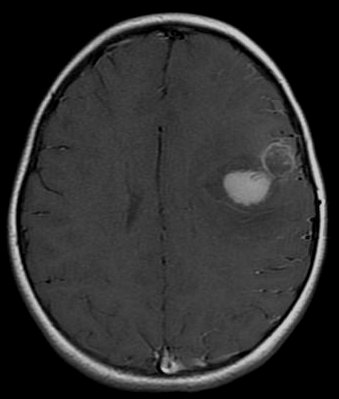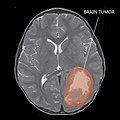Central nervous system primitive neuroectodermal tumor

Editor-In-Chief: Prab R Tumpati, MD
Obesity, Sleep & Internal medicine
Founder, WikiMD Wellnesspedia &
W8MD medical weight loss NYC and sleep center NYC
| Central nervous system primitive neuroectodermal tumor | |
|---|---|

| |
| Synonyms | CNS PNET |
| Pronounce | N/A |
| Specialty | N/A |
| Symptoms | Headache, nausea, vomiting, seizures, neurological deficits |
| Complications | Hydrocephalus, metastasis |
| Onset | Typically in children and young adults |
| Duration | Variable |
| Types | Medulloblastoma, pineoblastoma, ependymoblastoma |
| Causes | Unknown |
| Risks | Genetic predisposition, radiation exposure |
| Diagnosis | MRI, CT scan, biopsy |
| Differential diagnosis | Medulloblastoma, atypical teratoid rhabdoid tumor, ependymoma |
| Prevention | N/A |
| Treatment | Surgery, radiation therapy, chemotherapy |
| Medication | N/A |
| Prognosis | Variable, depends on type and stage |
| Frequency | Rare |
| Deaths | Varies |
Central nervous system primitive neuroectodermal tumor (CNS PNET) is a rare and highly aggressive cancer that primarily affects children and young adults. It is a type of neuroectodermal tumor that originates from the neural crest cells in the central nervous system.
Classification[edit]
CNS PNETs are classified as embryonal tumors, a category of neoplasms that also includes medulloblastoma and atypical teratoid rhabdoid tumor (ATRT). They are further classified based on their location in the brain, with the most common types being cerebral, pineal, and spinal.
Symptoms[edit]
The symptoms of CNS PNETs vary depending on the location of the tumor. Common symptoms include headache, nausea, vomiting, and changes in behavior or personality. In some cases, the tumor may cause seizures or neurological deficits.
Diagnosis[edit]
Diagnosis of CNS PNETs typically involves a combination of neuroimaging techniques, such as magnetic resonance imaging (MRI) and computed tomography (CT) scans, and biopsy to confirm the diagnosis. Histopathology and immunohistochemistry are also used to differentiate CNS PNETs from other types of brain tumors.
Treatment[edit]
Treatment for CNS PNETs usually involves a combination of surgery, radiation therapy, and chemotherapy. The goal of treatment is to remove as much of the tumor as possible and to kill any remaining cancer cells. Despite aggressive treatment, the prognosis for CNS PNETs is generally poor, with a five-year survival rate of less than 50%.
Research[edit]
Research into CNS PNETs is ongoing, with a focus on understanding the genetic and molecular mechanisms that drive these tumors. This research may lead to the development of new treatments and improve the prognosis for individuals with this disease.
Gallery[edit]
-
Histology of Medulloepithelioma
-
Ependymoblastomatous Rosette
-
MRI of Central nervous system primitive neuroectodermal tumor

This article is a neuroscience stub. You can help WikiMD by expanding it!
Ad. Transform your life with W8MD's Budget GLP-1 injections from $75


W8MD offers a medical weight loss program to lose weight in Philadelphia. Our physician-supervised medical weight loss provides:
- Weight loss injections in NYC (generic and brand names):
- Zepbound / Mounjaro, Wegovy / Ozempic, Saxenda
- Most insurances accepted or discounted self-pay rates. We will obtain insurance prior authorizations if needed.
- Generic GLP1 weight loss injections from $75 for the starting dose.
- Also offer prescription weight loss medications including Phentermine, Qsymia, Diethylpropion, Contrave etc.
NYC weight loss doctor appointmentsNYC weight loss doctor appointments
Start your NYC weight loss journey today at our NYC medical weight loss and Philadelphia medical weight loss clinics.
- Call 718-946-5500 to lose weight in NYC or for medical weight loss in Philadelphia 215-676-2334.
- Tags:NYC medical weight loss, Philadelphia lose weight Zepbound NYC, Budget GLP1 weight loss injections, Wegovy Philadelphia, Wegovy NYC, Philadelphia medical weight loss, Brookly weight loss and Wegovy NYC
|
WikiMD's Wellness Encyclopedia |
| Let Food Be Thy Medicine Medicine Thy Food - Hippocrates |
Medical Disclaimer: WikiMD is not a substitute for professional medical advice. The information on WikiMD is provided as an information resource only, may be incorrect, outdated or misleading, and is not to be used or relied on for any diagnostic or treatment purposes. Please consult your health care provider before making any healthcare decisions or for guidance about a specific medical condition. WikiMD expressly disclaims responsibility, and shall have no liability, for any damages, loss, injury, or liability whatsoever suffered as a result of your reliance on the information contained in this site. By visiting this site you agree to the foregoing terms and conditions, which may from time to time be changed or supplemented by WikiMD. If you do not agree to the foregoing terms and conditions, you should not enter or use this site. See full disclaimer.
Credits:Most images are courtesy of Wikimedia commons, and templates, categories Wikipedia, licensed under CC BY SA or similar.
Translate this page: - East Asian
中文,
日本,
한국어,
South Asian
हिन्दी,
தமிழ்,
తెలుగు,
Urdu,
ಕನ್ನಡ,
Southeast Asian
Indonesian,
Vietnamese,
Thai,
မြန်မာဘာသာ,
বাংলা
European
español,
Deutsch,
français,
Greek,
português do Brasil,
polski,
română,
русский,
Nederlands,
norsk,
svenska,
suomi,
Italian
Middle Eastern & African
عربى,
Turkish,
Persian,
Hebrew,
Afrikaans,
isiZulu,
Kiswahili,
Other
Bulgarian,
Hungarian,
Czech,
Swedish,
മലയാളം,
मराठी,
ਪੰਜਾਬੀ,
ગુજરાતી,
Portuguese,
Ukrainian




